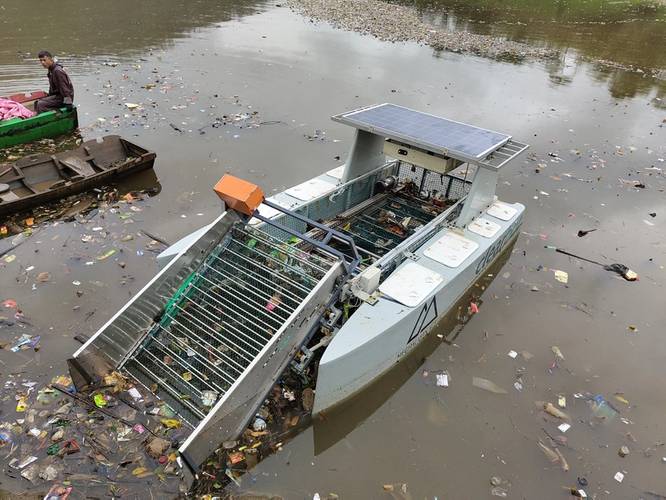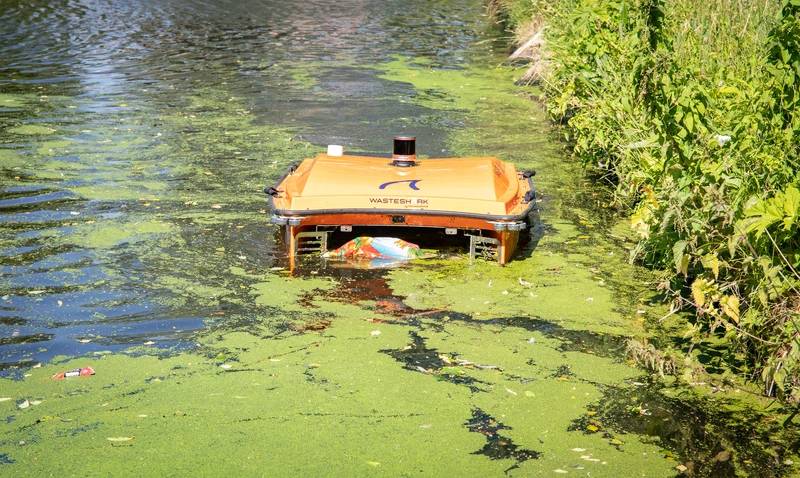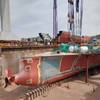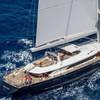Clean Up Vessels are Smarter than Fishing for Trash
There is a small but global fleet of clean up boats preventing trash from flowing into the ocean. More than that, these battery-powered, autonomous boats are performing a growing range of other tasks.
For the developers of Clearbot, the inspiration to be involved in removing trash from waterways arose from personal experience. They had watched villagers in India catching fish in rivers carpeted with trash and surfers in Bali manually hauling in trash from otherwise beautiful beaches.
Samyuktha Sriram, Head of Business Development and Marketing, recounts how, with no common language between them, the Clearbot team was able to teach an Indian villager how to use its boat’s remote control to clear around 80kg of trash an hour. “We designed the system to be as intuitive as possible. Operating the boat is almost as simple as using a remote-controlled device, but with far greater impact.”
As for the surfers earning a living doing the arduous and dangerous work of manual cleanup of beaches, she says: “We don't want to put people out of jobs. We want to build a very usable solution that anyone can learn, so that they can continue to do the work that they do, just at a larger scale.”
The company was started by university students Sidhant Gupta and Utkarsh Goel in 2019, and the partners built their first prototype in the hotel they were staying at in Bali and tested it in a swimming pool. Now they have offices in Hong Kong, India and Thailand.
Development has continued, and they have added a larger model capable of handling 200kg of trash an hour and storing 1.5 tons onboard. They have also installed solar panels so the vessels are self-charging, and they have bolstered vessel autonomy with the development of in-house object avoidance software. Onboard cameras provide a record of the trash collected, and in-house AI modelling classifies the trash for analysis by local authorities.
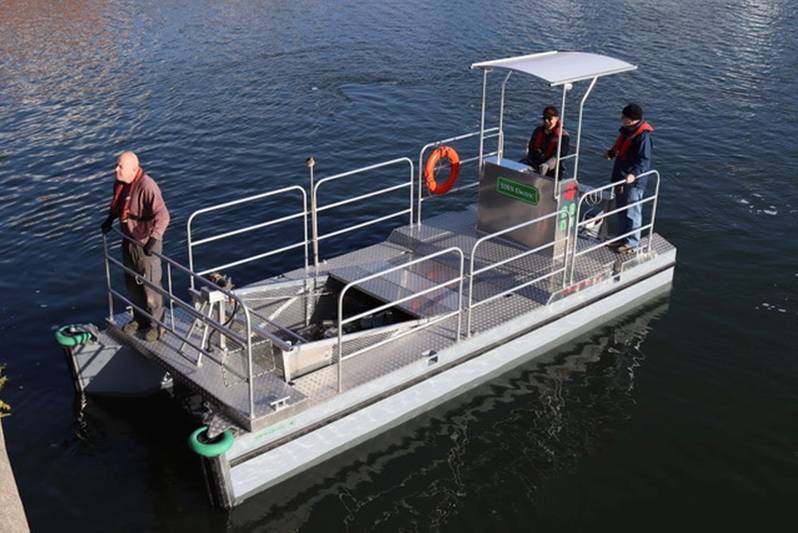 Up to 70% recycled aluminum is used in the hull of Sea Watch vessels.
Up to 70% recycled aluminum is used in the hull of Sea Watch vessels.
Source Water Witch
Clearbot has also partnered with Lloyd’s Register to help meet the national and international standards that will facilitate their boats’ entry into more countries and more markets. Sriram highlights the versatility of the collection system which can also clear aquatic pests such as water hyacinth. The small autonomous vessels can be useful in other hazardous environments too. They have been used to survey the dark, narrow waters under a bridge that was under construction.The addition of water quality sensors and samplers offers more functionality as does bathymetric survey equipment or even storage space for marina deliveries. As multi-functional units, the boats are modular and can be converted from one operation to another in less than an hour.
Michael Arens, co-founder of Clean Earth Rovers in the US, adds the cleanup of dead fish to his vessel’s extensive versatility. Red tides in Florida, for example, have causes mass deaths that pose a health hazard to those involved in manual cleanup. With a series of attachments, the company’s rovers can collect dead fish, spray herbicides or clean up oil. A simple two-prong automotive plug is used for the various attachments which plug into the vessel’s charging port.
For Arens, the motivation for developing the technology is to be part of the community and environmental stewardship that is fostered around marinas. “We like to work with groups, both in the private and public sector, to help leave behind a legacy of sustainability.”
For RanMarine founder Richard Hardiman, the inspiration came as he watched a boat crew cruise around a waterway in South Africa scooping up trash with a net better suited to cleaning a swimming pool.
Rotterdam-based RanMarine now counts Disney World, the Hudson River Park, PortsToronto, Babcock Marine Naval Bases UK and the Port of Houston amongst its clients. The company’s latest generation of boat offers seated onboard operation, remote control from shore or autonomous navigation with LiDAR-based collision avoidance.
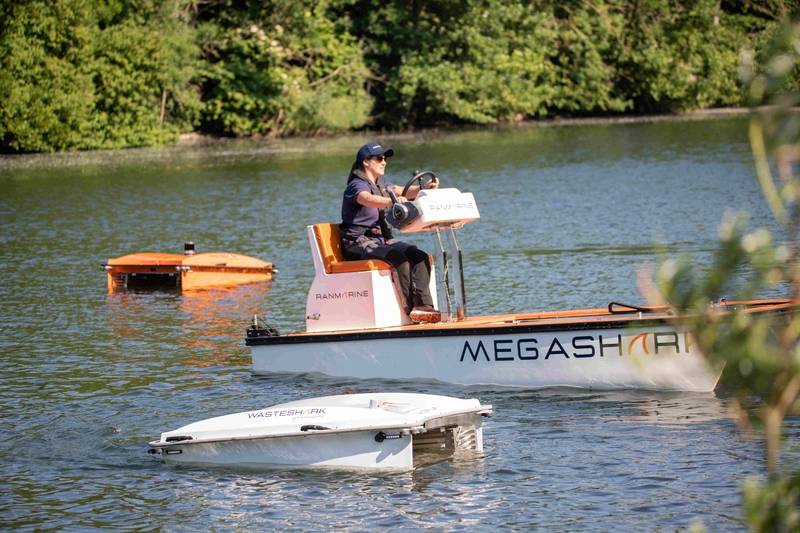 RanMarine offers boats with seated onboard operation, remote control from shore or autonomous navigation with LiDAR-based collision avoidance.
RanMarine offers boats with seated onboard operation, remote control from shore or autonomous navigation with LiDAR-based collision avoidance.
Source RanMarine
Rather than just being part of a reactive, cleanup operation, Hardiman has a strong focus on proactive pollution control through the gathering of real-time water quality data. This data feeds into impact reports that can inform management decisions and update regulators and the public on proactive pollution mitigation efforts. The collected data can establish baselines, identify temporal changes in water quality and waste accumulation and be used to encourage collaboration between local communities, harbor authorities and environmental agencies.Water Witch’s director Jackie Caddick has added another dimension to environmental stewardship.
The UK-based company has over 90 vessels in service worldwide including in Hong Kong, New York, Cape Town, Kuwait and London, and a key feature is the aluminum construction of the vessels. Up to 70% of the aluminum used has been recycled. Aluminum is a great example of a circular product, says Caddick, as it retains its financial value. Aluminum is lighter and has a longer lifespan that steel, fiberglass or plastic, so the boats easily last 30-40 years, leading to a low whole-of-life carbon footprint.
The vessels are powered by electric drives supplied by Torqeedo, and Caddick points to the importance of electric propulsion as more and more clients work towards net-zero emissions by 2030. “Electric propulsion is advancing fast, and by concentrating on building 100% electric systems, not just the motor but all onboard equipment, and from environmentally friendly, sustainable materials, we are able to offer a unique design.”
The company’s latest design includes Marine AI’s autonomous software solution: GUARDIAN. GUARDIAN Vision provides human-in-the-loop object detection and classification, and the AI functionality can provide a COLREG-compliant level of control using the Guardian AUTONOMY software suite.
GUARDIAN’s advanced data analytics enable full automation of the cleanup process and optimize the retrieval of marine litter and ocean plastic. The detailed data captured by GUARDIAN gives insight into the location and predicted movement of plastics, the variations and density of any hotspots and the characteristics of the litter. The AI technology uses monitoring, modelling and machine learning capability to increase recovery capacity, endurance and the cost-efficiency of the cleanup process.
“Over 90% of marine debris reaches the ocean from rivers,” says Caddick. “By reducing the flow of plastics and waste in our inland waterways rivers and estuaries we can really make a huge difference.”






